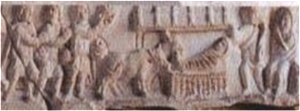During the Age of Taurus (roughly from 3000 BCE to 800 BCE), the bull and the calf were venerated. As this Age transitioned to Aries, the Mithraic Mysteries arose where the cosmic Christ was sought as one overcame the bull within: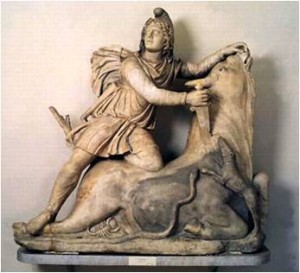
Note the symbol of the snake. Mithraism apparently grew out of Persia and became popular throughout much of the Roman empire just before the spread of Christianity.
Many of the Old Testament books have the expression ox and ass. For example, in Job 1:14 it says “and there came a messenger unto Job and said, “The oxen were plowing and the asses feeding beside them,”
Andrew Graham-Dixon of the Independent writes in his Arts column from December 1992, “The first reference to the ox and ass at the Nativity comes several centuries after the fact, in a book that is not much read these days: the Gospel of Pseudo-Matthew, written [down] some time in the eighth century [most researchers date this to 600 AD]. The author of this apocryphal text is unlikely to have invented this detail on his own. It seems probable that the early church fathers had also placed the ox and the ass at the Nativity because of what seemed a suggestive reference to the two animals in the Book of Isaiah: ‘The ox knows its owner and the ass its master’s stall; but Israel, my own people, has no knowledge, no discernment.’” The Adelphia Sarcophagus relief (to the left) is from roughly 330 AD; note the ox and ass in its nativity scene.
Giotto also places the ox and ass in his nativity scene. 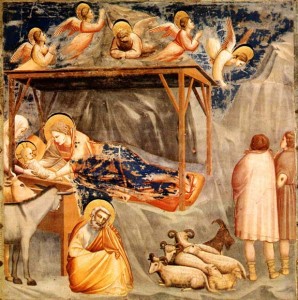 In his Escape to Egypt and the triumphant entry of Christ Jesus to Jerusalem includes an ass for travel (frescoes by Giotto).
In his Escape to Egypt and the triumphant entry of Christ Jesus to Jerusalem includes an ass for travel (frescoes by Giotto).
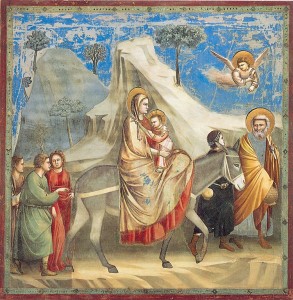 In Luke 13:15 we read “The Lord then answered him, and said, Thou hypocrite, doth not each one of you on the sabbath loose his ox or his ass from the stall, and lead him away to watering?”
In Luke 13:15 we read “The Lord then answered him, and said, Thou hypocrite, doth not each one of you on the sabbath loose his ox or his ass from the stall, and lead him away to watering?”
A bit later in Luke, 14:5, it says “And answered them, saying, Which of you shall have an ass or an ox fallen into a pit, and will not straightway pull him out on the sabbath day?”
OK, lots of other references are possible – you likely are aware there are many such references in the Bible and other related ancient texts. I have had a question about the symbolic or mystical purpose of these two beasts. In reading David Ovason’s book The Two Children, I found a treasure! “The ox was intended as a reference to the bull of Mithras, and perhaps even to the bull of the Egyptian god Apis – both important cults still offering initiation at the time of the birth of Jesus. … Just as the bull would have been familiar to the early Christians as being emblematic of the Mithraic cult, so the ass would have been familiar to them through the writing of the 2nd century AD African writer Lucius Apulcius.” Apulcius’ esoteric book The Golden Ass, is the story of a “human who had been metamorphosed into the body of an ass” but finds liberation through the “initiation rites of Isis”. David goes on to say that Gnostic deities were depicted with the head of an ass.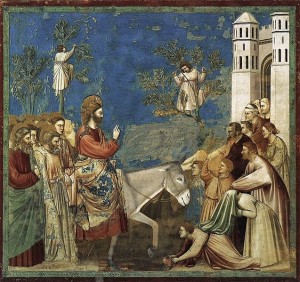
The gospel books are full of passages where the event could be happening in the physical or in the spiritual world or both (typically both). I find it plausible that both the bull (ox) and the ass each represent a stream of the ancient mysteries. Linking the bull to Mithras and Egyptian Apis mysteries makes sense. And I can be persuaded that the ass represents the Osiris-Isis mysteries of Egypt but I’ll need more persuasion. Anyone want to persuade me?
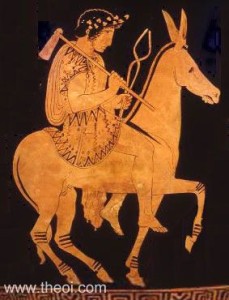 To close I’d like to add one more image. When Hephaestus returned to Mount Olympus, many years after his mother, Hera, threw him off because his foot was deformed and thus ugly, he rode on an ass. Christ did not copy this; rather he fulfilled the myths and the prophecies. What does this riding into Jerusalem or onto Olympus truly mean?
To close I’d like to add one more image. When Hephaestus returned to Mount Olympus, many years after his mother, Hera, threw him off because his foot was deformed and thus ugly, he rode on an ass. Christ did not copy this; rather he fulfilled the myths and the prophecies. What does this riding into Jerusalem or onto Olympus truly mean?
